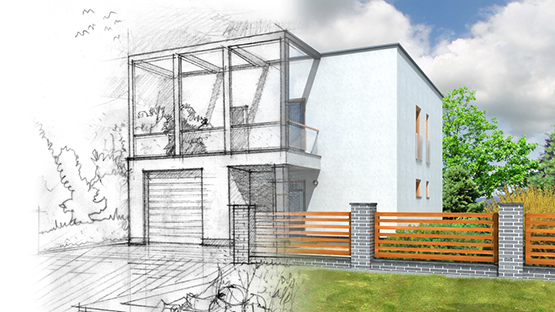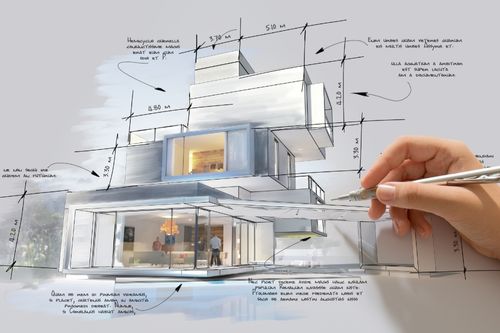The Effect of Technological Advancements on the Style Practices of Contemporary Architects
The fast development of technical tools has actually considerably improved the layout landscape for modern architects, fostering unprecedented degrees of technology and sustainability. The integration of Structure Details Modeling (BIM), parametric style, and expert system has not only structured collaboration among diverse teams but additionally redefined job execution. As designers welcome these developments, they are faced with intricate difficulties that might influence their innovative processes. Checking out these characteristics discloses a nuanced interplay in between innovation and conventional layout methods, prompting a closer assessment of what the future holds for building techniques.
Advancement of Architectural Devices
Exactly how have architectural tools transformed the style and construction procedures over the centuries? The evolution of building devices has considerably affected the performance, accuracy, and creativity of style and building and construction. In old times, architects rely upon basic instruments such as plumb bobs, determining rods, and basic geometry to develop frameworks. These devices laid the structure for very early building method, enabling the construction of legendary structures, albeit with constraints in accuracy and intricacy.
With the development of the Renaissance, the introduction of the compass and the protractor marked a crucial shift. These devices made it possible for designers to achieve higher accuracy in their layouts, helping with the emergence of even more elaborate and proportional structures (cda architects). The Industrial Transformation additionally changed architectural method with the intro of mechanical tools and products, enabling for larger and extra ambitious tasks
In the 20th century, the growth of computer-aided style (CAD) software program changed the landscape once more, giving architects with extraordinary abilities in modeling and visualization. Today, advanced tools such as Building Info Modeling (BIM) and parametric style software program continue to push the boundaries of building advancement, allowing an extra integrated approach to style and construction procedures.

Enhanced Partnership in Layout
As innovation proceeds to progress, improved partnership in layout has become a cornerstone of modern-day building method. The assimilation of digital tools such as Structure Info Modeling (BIM), cloud-based platforms, and progressed visualization software has actually changed the way architects, designers, and stakeholders engage throughout the design process. These devices promote real-time interaction, allowing groups to share ideas, alterations, and comments instantly, no matter of geographical place.
Furthermore, digital reality (VIRTUAL REALITY) and enhanced reality (AR) have more enriched joint efforts by making it possible for immersive experiences that allow clients and team participants to picture jobs in a more interesting manner. This level of communication not only boosts understanding however also cultivates a feeling of possession among stakeholders, bring about even more informed decision-making.
Furthermore, interdisciplinary cooperation has been streamlined via these technological improvements, making it possible for architects to work much more closely with various other specialists, such as metropolitan organizers and environmental professionals. The outcome is a more cohesive strategy to develop that considers numerous viewpoints and proficiency. Eventually, boosted cooperation in design is not merely a trend; it is vital Extra resources for producing ingenious, practical, and cosmetically pleasing style in a significantly intricate globe.
Sustainability Via Modern Technology
Sustainability in style has actually increasingly become linked with technological advancement, driving the sector toward environmentally responsible methods - cda architects. Contemporary designers are leveraging advanced technologies to reduce environmental impact while boosting the efficiency of structures. One popular example is the use of Structure Details Modeling (BIM), which permits exact planning and resource appropriation, lowering waste throughout building and promoting power effectiveness throughout a building's lifecycle
Moreover, clever products and energy-efficient systems are being integrated right into go to the website styles to maximize resource use. Technologies such as solar batteries and environment-friendly roofing systems harness renewable resource sources, adding to lowered carbon impacts. Furthermore, the application of expert system in style processes allows architects to replicate and analyze energy intake, guiding decisions toward even more lasting results.
The assimilation of lasting technologies not just aligns with worldwide ecological goals yet additionally satisfies an enhancing need from consumers for green options. As architects welcome these innovations, the emphasis changes in the direction of developing spaces that are not only aesthetically pleasing however additionally functionally sustainable, consequently redefining the requirements of modern-day style. This way, modern technology serves as a stimulant for sustainability, making it possible for designers to develop buildings that respect and improve the natural surroundings.
Difficulties in Implementation
While technological advancements in style hold excellent guarantee for improving sustainability, their execution typically comes across considerable challenges. One key obstacle is the steep understanding contour linked with new innovations. Designers and building specialists might call for extensive training to successfully use innovative software application and devices, which can delay task timelines and enhance costs.
Additionally, the combination of arising innovations, such as Structure Details Modeling (BIM) and lasting products, commonly demands cooperation throughout multidisciplinary groups. This cooperation can be impeded by differences in know-how, workflows, and communication designs, causing prospective problems and inadequacies.
Financial restraints additionally complicate the fostering of cutting-edge technologies. Several architectural firms, particularly smaller ones, might do not have the resources to buy innovative tools, limiting their ability to complete with bigger firms that can pay for such investments.
In addition, governing frameworks and structure codes might not keep pace with technical improvements, producing obscurity and potential compliance issues. This challenge can inhibit designers from fully welcoming new modern technologies, as the threat of non-compliance may surpass the advantages. As a result, resolving these execution obstacles is important for the successful assimilation of technical advancements in modern building methods.
Future Trends in Style
The challenges connected with the implementation of new modern technologies in style have actually triggered a reevaluation of future trends within the industry. As designers browse concerns such as sustainability, urbanization, and social equity, they are progressively taking on ingenious innovations to improve design efficiency and environmental performance.
One popular pattern is the integration of expert system (AI) in the layout process. AI devices can assess large datasets to notify style decisions, enhancing both creativity find this and performance. Structure Information Modeling (BIM) proceeds to advance, making it possible for real-time collaboration among stakeholders and helping with streamlined job administration.
Sustainable style methods are likewise gaining energy, with designers concentrating on flexible reuse and regenerative layout concepts that reduce source usage and waste. The unification of smart products and sustainable power resources will certainly further improve the resilience of buildings despite climate adjustment.
In addition, the increase of parametric layout permits for more tailored and context-sensitive building remedies. By using these advancements, designers are poised to develop constructed environments that not just deal with the prompt demands of society yet additionally anticipate future challenges, consequently redefining the duty of design in an ever-changing globe.
Conclusion

Comments on “Changing Areas: The Vision of CDA Architects for Modern Living”